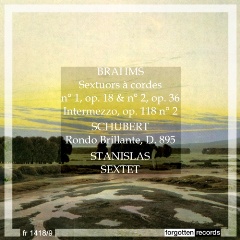The Stanislas Sextet associates the members of the Stanislas Quartet and two American musiciens, the violonist and viola player, John Fadial, and the cellist Beth Vanderborgh. They met in Nancy in 1994 and decided to explore together the magnificent repertoire for string sextets. In 1996 they gave their first concert in the Salle Poirel in Nancy, followed by a tour of America, which took them successively to West Virginia, North Carolina, Maryland and finally Washington, where their interpretation of the first sextet of Brahms was particularly appreciated by the critic of the Washington Post.
Since then the Stanislas Sextet has regularly performed on both sides of the Atlantic, with undeniable success. Between 1997 and 2000 it led the French-American Academy of Strings, which takes place successively in Mirecourt, the cradle of French string instrument fabrication, and the University of West Virginia. In October 2006 and 2009, the Stanislas Sextet was invited in residence at the University of North Carolina in Greensboro, where master-classes alternated with concerts in Greensboro and in other towns in North Carolina. The concert given in the Fine Arts Museum of North Carolina in Raleigh, capital of the State, resulted in an enthusiastic article in Classical Voice.
The Stanislas Sextet has celebrated his 20th anniversary in 2016 in France, giving several concerts Salle Poirel in Nancy, and some masteclasses at the Conservatoire.
|
“…Separatly they were fine; together they were excellent. Brahms's String Sextet No1 in B-flat, OP.18, a large, genial piece of music, demands flourish and open heart. The ensemble brought both-with the appropriate results….” Mark Carrington THE WASHINGTON POST (March 29.1996) «… Great evening, with the sextet by Richard Strauss, followed by the first Brahms’s sextet. An outstanding performance…” EST REPUBLICAIN ( Nancy, July 7. 1997) “... In Brahms sextet n.2, they played with impeccable ensemble, rhythmic precision, technical expertise and expansive, passionate musicianship. Gorgeous music, exquisitely performed, and I do not believe I have overdone the superlatives….” Ken Hoover CLASSICAL VOICE OF NORTH CAROLINA (October 2006) |


